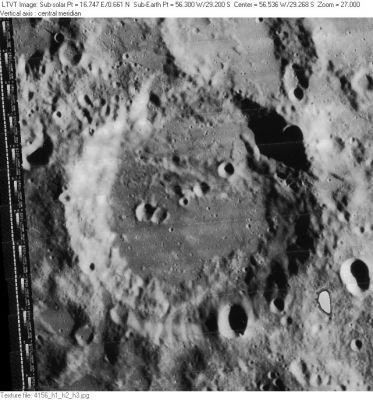Difference between revisions of "Vieta"
(Created page with "<div id="content_view" class="wiki" style="display: block"> =Vieta= {| class="wiki_table" | Lat: 29.2°S, Long: 56.3°W, Diam: 87 km, Depth: 4.5 km, [/R%C3%BCkl%2051 Rükl...") |
|||
| Line 38: | Line 38: | ||
* South of '''Vieta''', at 58° West/ 33°30' South, is the location of two officially unnamed dark mare patches, unofficially called '''''Basaltic Lava Areas''''' by Harold Hill. There's a remarkable photograph of Hill's '''''Basaltic Lava Areas''''' on page 62 of Charles A. Wood's and Maurice J. S. Collins's ''21st Century Atlas of the Moon'' (fourth photograph, at lower right). <span class="membersnap">- [http://www.wikispaces.com/user/view/DannyCaes [[Image:DannyCaes-lg.jpg|16px|DannyCaes]]] [http://www.wikispaces.com/user/view/DannyCaes DannyCaes] <small>Aug 3, 2015</small></span> | * South of '''Vieta''', at 58° West/ 33°30' South, is the location of two officially unnamed dark mare patches, unofficially called '''''Basaltic Lava Areas''''' by Harold Hill. There's a remarkable photograph of Hill's '''''Basaltic Lava Areas''''' on page 62 of Charles A. Wood's and Maurice J. S. Collins's ''21st Century Atlas of the Moon'' (fourth photograph, at lower right). <span class="membersnap">- [http://www.wikispaces.com/user/view/DannyCaes [[Image:DannyCaes-lg.jpg|16px|DannyCaes]]] [http://www.wikispaces.com/user/view/DannyCaes DannyCaes] <small>Aug 3, 2015</small></span> | ||
| − | * The region south of '''Vieta''' (between '''Lehmann''' and '''Vieta''') seems to be occupied by several rather large unnamed craters (or vaguely observable small impact basins). That's how it looks on [http://the-moon. | + | * The region south of '''Vieta''' (between '''Lehmann''' and '''Vieta''') seems to be occupied by several rather large unnamed craters (or vaguely observable small impact basins). That's how it looks on [http://the-moon.us/wiki/SLC-F7 SLC map F7]. <span class="membersnap">- [http://www.wikispaces.com/user/view/DannyCaes [[Image:DannyCaes-lg.jpg|16px|DannyCaes]]] [http://www.wikispaces.com/user/view/DannyCaes DannyCaes] <small>Jan 31, 2017</small></span> |
<br /> | <br /> | ||
==LPOD Articles== | ==LPOD Articles== | ||
Revision as of 20:33, 11 April 2018
Contents
Vieta
|
Lat: 29.2°S, Long: 56.3°W, Diam: 87 km, Depth: 4.5 km, [/R%C3%BCkl%2051 Rükl: 51] |
Table of Contents

LO-IV-156H
Images
LPOD Photo Gallery Lunar Orbiter Images
Maps
([/LAC%20zone LAC zone] 92C4) LAC map Geologic map
Description
Description: Elger
([/IAU%20Directions IAU Directions]) VIETA.--One of the finest objects in the third quadrant; a ring-plain 51 miles in diameter, with broad lofty walls, a peak on the east rising to nearly 11,000 feet, and another N. of it to considerably more than 14,000 feet above the interior. It is bounded by a linear border, approximating very closely to an hexagonal shape, which is broken by many gaps and cross-valleys. On the S., the S.E. and S.W. sections of the wall do not meet, being separated by a wide valley flanked on the E. by a fine crater, which has broken down the rampart at this place. The N. border is likewise intersected by valleys and by a crater-row. The inner slopes are conspicuously terraced. There is a very inconspicuous central mountain and several large craters on the floor, some of them double. Ten have been counted on the N. half of the interior. On the S.W. of Vieta are two fine overlapping ring-plains, with a crater on the wall common to both.
- The "overlapping ring-plains" that Elger mentions to Vieta's south-west are presumably the [/satellite%20feature lettered craters] Vieta A and B.
Description: Wikipedia
Additional Information
- Depth data from [/Kurt%20Fisher%20crater%20depths Kurt Fisher database]
- Westfall, 2000: 0.93 km
- Viscardy, 1985: 4.5 km
- Cherrington, 1969: 5.3 km
- Westfall's estimate for Vieta's depth appears to be in error (a typo in the database?).
- From the shadow in LO-IV-156H, the sunlit peak on Vieta's northwest rim rises at least 4680 m (15,350 ft) above the crater floor. The longest part of the shadow may be interrupted by a hill.
- From the shadows in [/Consolidated%20Lunar%20Atlas Consolidated Lunar Atlas] plates F23 and G21, the NW peak appears to rise as much as 4830 m (15,850 ft) above more distant parts of the crater floor, in reasonable agreement with Elger's estimate. At the eastern midpoint, where the rim has a crumbled appearance in the Lunar Orbiter view, the Earth-based plates indicate its height above the floor dips to about 3100 m. South of that it rises again to about 3600 m (11,810 ft). This value is again in good agreement with Elger's estimate, although the shadows indicate a very gradual rise rather than the distinct peak Elger mentions.
Nomenclature
- Named for François Viète (or Vieta), seigneur de la Bigotière (1540 - February 13, 1603), a French mathematician. Vieta discovered the key to a Spanish cipher, consisting of more than 500 characters, and this meant that all dispatches in that language which fell into the hands of the French could be easily read. However, his fame now rests entirely on his achievements in mathematics.
- According to [/Whitaker Whitaker] (p. 215), this name was introduced (in the form Vietae) by [/Riccioli Riccioli]. On his map it seems to have referred to a complex of four craters: the present Vieta, Vieta A, Vieta B, and [/Fourier Fourier]. When and by whom the name became associated with the present crater alone is unclear.
Harold Hill's Basaltic Lava Areas
- South of Vieta, at 58° West/ 33°30' South, is the location of two officially unnamed dark mare patches, unofficially called Basaltic Lava Areas by Harold Hill. There's a remarkable photograph of Hill's Basaltic Lava Areas on page 62 of Charles A. Wood's and Maurice J. S. Collins's 21st Century Atlas of the Moon (fourth photograph, at lower right). - DannyCaes DannyCaes Aug 3, 2015
- The region south of Vieta (between Lehmann and Vieta) seems to be occupied by several rather large unnamed craters (or vaguely observable small impact basins). That's how it looks on SLC map F7. - DannyCaes DannyCaes Jan 31, 2017
LPOD Articles
Bibliography
[/A%20Portfolio%20of%20Lunar%20Drawings A Portfolio of Lunar Drawings] (Harold Hill), pages 156, 157 (the Basaltic Lava Areas south of Vieta).
This page has been edited 1 times. The last modification was made by - tychocrater tychocrater on Jun 13, 2009 3:24 pm - afx3u2